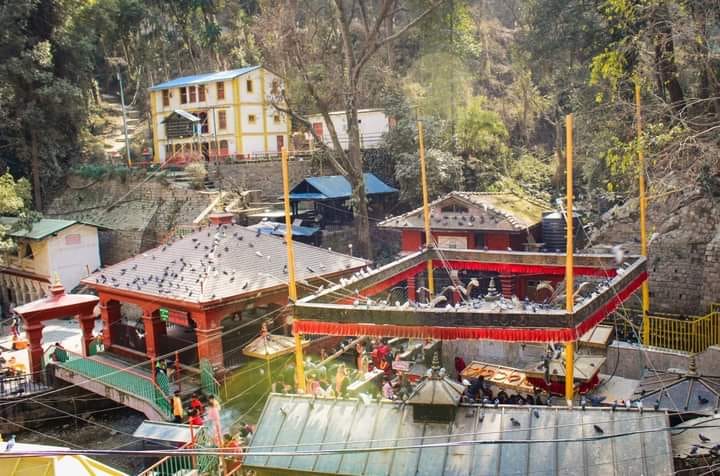Dakshinkali Temple, also known as Dakshin Kali Temple, located 18-20 kilometers outside Kathmandu and about 1 kilometer outside the village of Pharping, is one of the major sacred Hindu temples in Nepal dedicated to the goddess Kali. It is in South of Kathmandu City Valley surrounded by the evergreen forest Hills, is a beautiful Golden Shrine popularly known as Dakshin Kali.
Table of Contents
Who is Kali?
Kali who is said to be the blood-thirsty wife of Lord Shiva represents the destructive aspects of cosmic energy or Shakti. In the representation of arts, she is generally shown being black with long disheveled hair, having four hands and standing almost naked on a dead human body. Her being black is believed to symbolize the immeasurable depth of ever-watching time. She is also regarded as a great holder of the time cycle, which she is to keep moving without any stop. Her being depicted as standing up in a restless mood with long unkempt hair is to signify her non-stop activity. Her favorite jewelry is the garland of human heads, which she always wears.
 Symbol of four-hand of Kali
Symbol of four-hand of Kali
Her four hands symbolize her power spreading in all four directions. One of her hands holds the severed head of the human being and the other hand holds a drawn sword. However, two of her other arms indicate the gesture of boon giving and assurance for protection to her devotees. They symbolize the primordial energy, which Kali particularly represents. It should be remembered in this context that Kali is both the act and the agency of transformation. Her chopping of the human head symbolizes the compulsory sacrifices that must be made by every matter form to be transferred into its Supreme reality. The sharp sword that she holds signifies the supreme knowledge, which is free from Pride and Prejudice and every cut of this divine sword, stands for her great activities to keep the world moving.
Sacrifice at Dakshinkali Temple
There is the sacrifice of buffalo, goat, sheep, duck and rooster(cock) in Dakshinkali Temple. People usually choose the animals for sacrifices depending upon their status and wishes. Sometimes the rich Hindu families bring all five kinds of animals and have priests perform the long ritualistic worship, which is locally known as the pancha vali Puja. Otherwise, the commonest animal for sacrifice is the rooster and then the goat. The sheep and the ducks are sacrificed only in rare cases. However, those who cannot afford any of the sacrifices of animals never forget to bring raw eggs which are also believed to symbolize the live animals.
 Process of Sacrificing animals
Process of Sacrificing animals
It is interesting to note that before the sacrifice starts, animals are taken down to the steam for a purification bath and worshipped and fed with a little bit of all the foods prepared for the occasion. After that, the sacrificer undergoes the resolve rites with the priest seated right across and eventually sprinkles the Holy Water over the animals and wait till the animal gives thorough sake. This kind of ritual shake is regarded as mandatory and a wishful contest consent of the animal for the sacrifice.
soon after the head of the animal is chopped off, a small piece of its tail is immediately tucked in its mouth, which is to signify that its beastly nature is now gone forever. The sacrificers also set the animal head right in front of the Kali image and light the ritual lamp atop the head which is said to signify that the animal is now all enlightened. In any case, the worshippers always make a big feast out of the sacrificed animals and enjoy themselves.
You might also like to read: BUDHANILKANTHA TEMPLE
Sacrifice Day
Every Tuesday and Saturday (besides on other special occasions too) lots of devotees go to worship goddess Kali and make animals sacrifice in Dakshinkali Temple.
Legend
As the legend says, the goddess herself came to the dream of Malla King and asked him to make a nice temple with the idol which was found at the hill near Pharping. The main temple is just at the confluence of two holy Ganges Rivers. Just above the temple on a small hill, there is a goddess’s Mata Temple (Mother’s Temple) which gives a spectacular view of the surroundings.
Dakshinkali Temple timing
Dakshinkali temple is open on all days. Dakshinkali Temple Timing is from 06:00 am to 09:00 pm. We recommend the Best time to visit Dakshinkali Temple(preferred time): 08:00 am to 11:00 am. Tuesday and Saturday are the most crowded as these are the days to worship and sacrifice animals to goddess kali.
 How to get to Dakshinkali Temple?
How to get to Dakshinkali Temple?
Dakshinkali Temple is 22 km south of Kathmandu and takes around 1 hour to reach passing by many villages, terraced fields and forests. The road goes passing by Chovar and Pharping which are significantly important religiously and geographically. You can combine Chovar and Pharping with Dakshinkali Temple.
Some more information
There are so many small shops way to the temple that sells marigold flowers, coconuts, Incense sticks offered to the goddess and local vegetables, spices, snacks to the visitors make this place more interesting. Only Hindu devotees are allowed to go inside the main temple and taking photos is strictly prohibited inside the main temple premises.




